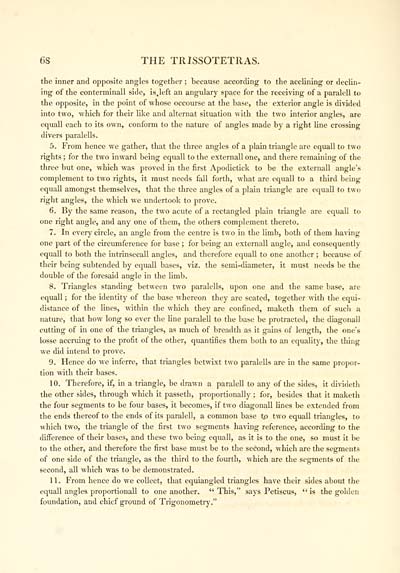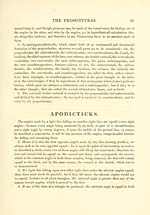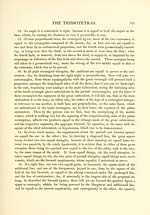Maitland Club > Works of Sir Thomas Urquhart
(110) Page 68
Download files
Complete book:
Individual page:
Thumbnail gallery: Grid view | List view

68 THE TRISSOTETRAS.
the inner and opposite angles together ; because according to the acclining or declin-
ing of the conterminall side, is.left an angulary space for the receiving of a paralell to
the opposite, in the point of whose occourse at the base, the exterior angle is divided
into two, which for their like and alternat situation with the two interior angles, are
equall each to its own, conform to the nature of angles made by a right line crossing
divers paralells.
5. From hence we gather, that the three angles of a plain triangle are equal] to two
rights ; for the two inward being equall to the externall one, and there remaining of the
three but one, which was proved in the first Apodictick to be the externall angle's
complement to two rights, it must needs fall forth, what are equall to a third being
equall amongst themselves, that the three angles of a plain triangle are equall to two
right angles, the which we undertook to prove.
6. By the same reason, the two acute of a rectangled plain triangle are equall to
one right angle, and any one of them, the others complement thereto.
7. In every circle, an angle from the centre is two in the limb, both of them having
one part of the circumference for base ; for being an externall angle, and consequently
equall to both the intrinsecall angles, and therefore equall to one another ; because of
their being subtended by equall bases, viz. the semi-diameter, it must needs be the
double of the foresaid angle in the limb.
8. Triangles standing between two paralells, upon one and the same base, are
equall ; for the identity of the base whereon they are seated, together with the equi-
distance of the lines, within the which they are confined, maketh them of such a
nature, that how long so ever the line paralell to the base be protracted, the diagonall
cutting of in one of the triangles, as much of breadth as it gains of length, the one's
losse accruing to the profit of the other, quantifies them both to an equality, the thing
we did intend to prove.
9. Hence do we inferre, that triangles betwixt two paralells are in the same propor-
tion with their bases.
10. Therefore, if, in a triangle, be drawn a paralell to any of the sides, it divideth
the other sides, through which it passeth, proportionally ; for, besides that it maketh
the four segments to be four bases, it becomes, if two diagonall bines be extended from
the ends thereof to the ends of its paralell, a common base tP two equall triangles, to
which two, the triangle of the first two segments having reference, according to the
difference of their bases, and these two being equall, as it is to the one, so must it be
to the other, and therefore the first base must be to the second, which are the segments
of one side of the triangle, as the third to the fourth, which are the segments of the
second, all which was to be demonstrated.
1 1 . From hence do we collect, that equiangled triangles have their sides about the
equall angles proportionall to one another. " This," says Petiscus, " is the golden
foundation, and chief ground of Trigonometry."
the inner and opposite angles together ; because according to the acclining or declin-
ing of the conterminall side, is.left an angulary space for the receiving of a paralell to
the opposite, in the point of whose occourse at the base, the exterior angle is divided
into two, which for their like and alternat situation with the two interior angles, are
equall each to its own, conform to the nature of angles made by a right line crossing
divers paralells.
5. From hence we gather, that the three angles of a plain triangle are equal] to two
rights ; for the two inward being equall to the externall one, and there remaining of the
three but one, which was proved in the first Apodictick to be the externall angle's
complement to two rights, it must needs fall forth, what are equall to a third being
equall amongst themselves, that the three angles of a plain triangle are equall to two
right angles, the which we undertook to prove.
6. By the same reason, the two acute of a rectangled plain triangle are equall to
one right angle, and any one of them, the others complement thereto.
7. In every circle, an angle from the centre is two in the limb, both of them having
one part of the circumference for base ; for being an externall angle, and consequently
equall to both the intrinsecall angles, and therefore equall to one another ; because of
their being subtended by equall bases, viz. the semi-diameter, it must needs be the
double of the foresaid angle in the limb.
8. Triangles standing between two paralells, upon one and the same base, are
equall ; for the identity of the base whereon they are seated, together with the equi-
distance of the lines, within the which they are confined, maketh them of such a
nature, that how long so ever the line paralell to the base be protracted, the diagonall
cutting of in one of the triangles, as much of breadth as it gains of length, the one's
losse accruing to the profit of the other, quantifies them both to an equality, the thing
we did intend to prove.
9. Hence do we inferre, that triangles betwixt two paralells are in the same propor-
tion with their bases.
10. Therefore, if, in a triangle, be drawn a paralell to any of the sides, it divideth
the other sides, through which it passeth, proportionally ; for, besides that it maketh
the four segments to be four bases, it becomes, if two diagonall bines be extended from
the ends thereof to the ends of its paralell, a common base tP two equall triangles, to
which two, the triangle of the first two segments having reference, according to the
difference of their bases, and these two being equall, as it is to the one, so must it be
to the other, and therefore the first base must be to the second, which are the segments
of one side of the triangle, as the third to the fourth, which are the segments of the
second, all which was to be demonstrated.
1 1 . From hence do we collect, that equiangled triangles have their sides about the
equall angles proportionall to one another. " This," says Petiscus, " is the golden
foundation, and chief ground of Trigonometry."
Set display mode to: Large image | Transcription
Images and transcriptions on this page, including medium image downloads, may be used under the Creative Commons Attribution 4.0 International Licence unless otherwise stated. ![]()
| Publications by Scottish clubs > Maitland Club > Works of Sir Thomas Urquhart > (110) Page 68 |
|---|
| Permanent URL | https://digital.nls.uk/82500441 |
|---|

